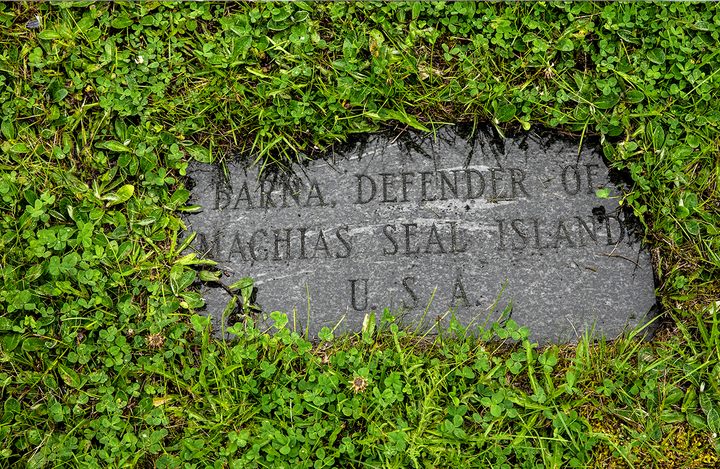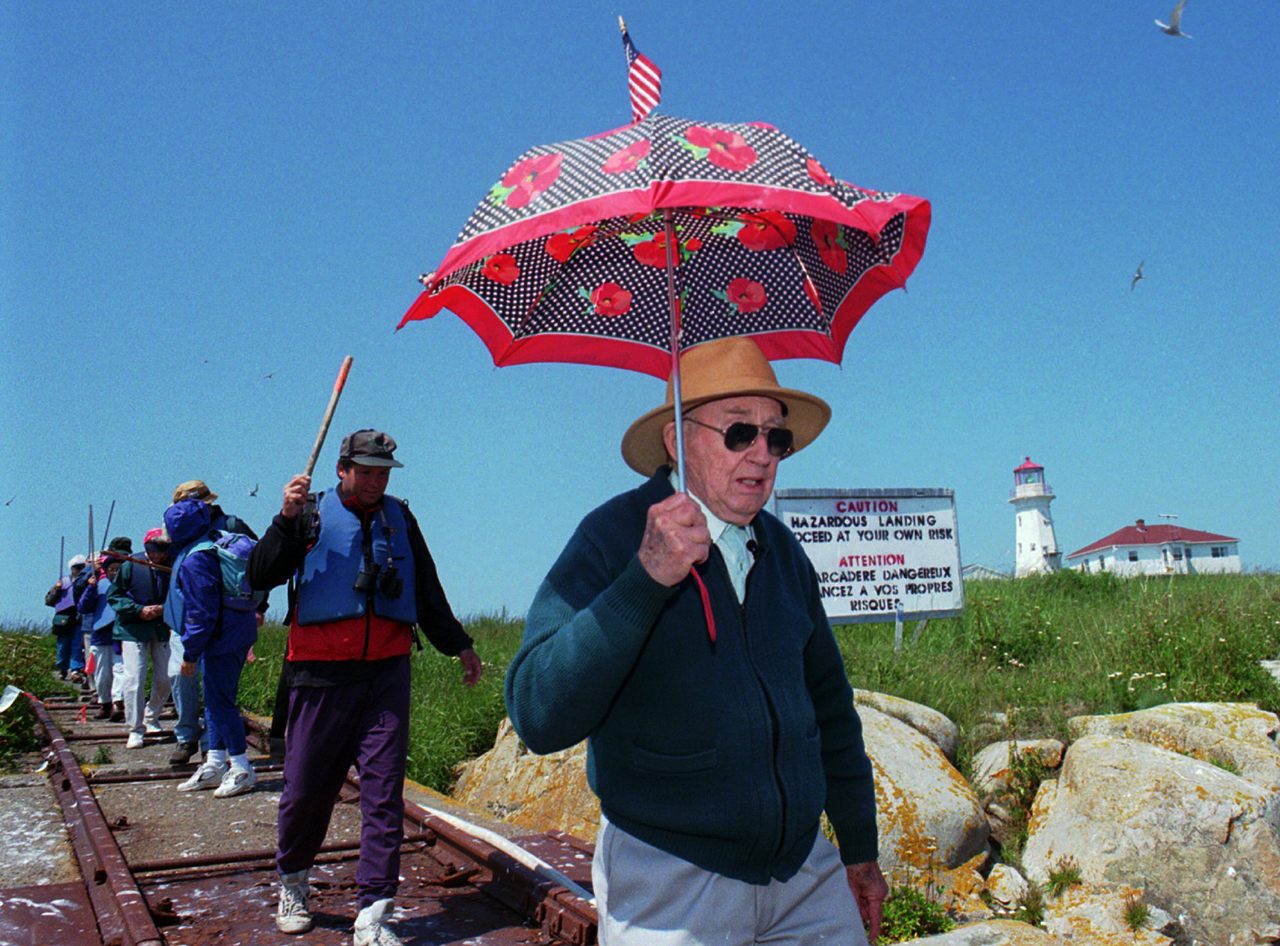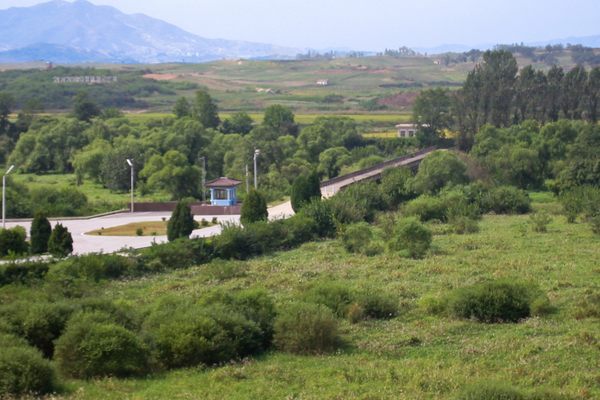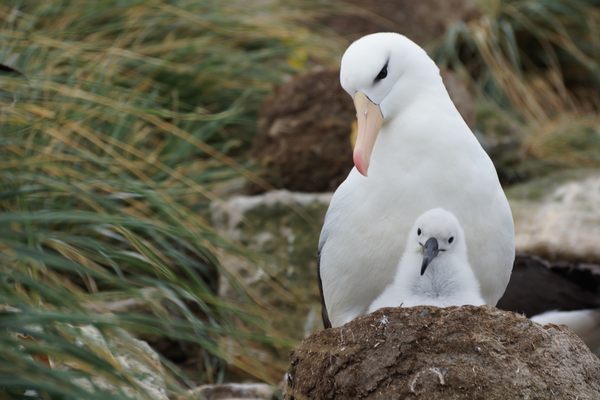
The Man Who Went to War With Canada
For centuries, the United States and Canada’s only remaining land border dispute has been kept alive by a single family.
In 1940, when he was 25 years old, Barna Norton went to a shipwrights’ shop in his hometown of Jonesport, Maine, and ordered a boat. It needn’t be big, he said, but it had to be sturdy. He was going to take it 20 nautical miles out of Jonesport Harbor, through chop and wind, to a 15-acre scrap of stone and grass called Machias Seal Island.
That June, Norton cast off in his new vessel, which he had named If. (“That was ‘If I can get this,’ or ‘If I can get that,’” he later explained.) He brought along his father, some adventurous tourists from nearby Roque Bluffs, and maybe a picnic. After probably a few hours at sea, they reached the island’s rocky shore, and managed to land among the island’s main residents: puffins, razorbills, murres, and Arctic terns.

Later, over decades of interviews with oral historians and reporters, he didn’t share many details about that first trip. But it must have gone well, because in the next 60 years, Barna Norton would travel to Machias Seal Island thousands of times. He would bring tens of thousands of people and lots of picnics, and captain a whole succession of boats, named with increasing confidence.
He would also tell—many, many times—a particular story. “I own the island,” went the simplest version. “It was given to me.”
This story conflicts with the official stances of two powerful nations. It flies in the face of the Canadian lighthouse that has stood on the island for nearly two centuries. It also complicates the United States’s position, which is to claim the disputed island as American territory without making too much of a fuss. But Norton never gave up on his story. In a time when the last thing most people want is another border controversy, I decided to try to find out why.
The Dispute
The border between Canada and the United States is the longest in the world. It spans 5,525 miles, separating the Yukon from Alaska, Saskatchewan from Montana, Ontario from New York. It hosts its share of difficulties: smuggling, undocumented crossings, the militarized edge that has come to characterize such spaces. But in terms of actual land disputes, things are calm the whole way through—almost.

Then you get to the northeast corner. Depending on whom you ask, Machias Seal Island is either off the coast of Maine or of Grand Manan. It’s also either American or Canadian. It is the only place with this particular unsettled identity that you can actually stand on top of. Although the ownership of some stretches of water is still contested, this island—and neighboring North Rock, which is even smaller and barer—are the last crumbs of their land the two countries don’t agree on.
Stephen Kelly, a former journalist and diplomat who summers in Jonesport and is a research scholar at Duke University, has been studying this dispute for over a decade. He has built up a sense of its progression, which he says “nicely illustrates a lot of the quirks of border-making.”
The American government traces its claim to the islands back to 1783, when the Treaty of Paris assigned “all islands within twenty leagues of any part of the shores of the United States” to that country, except for those that were already part of Nova Scotia.
The Canadians have a solid counter: the 1621 land grant that established Nova Scotia, then a British colony, which included “islands … within six leagues of any part” of that province’s coast. Machias Seal Island is a little over three leagues (almost 12 miles) from both Cutler, Maine, and the southern tip of Grand Manan, a large island west of Nova Scotia, which the two countries also quarreled over for many years.
If the world were more just, this would all be moot: The people of the Passamaquoddy Nation likely used the island long before anyone else even knew it existed. (“Machias,” also the name of precipitous local river, is a Passamaquoddy word that means “bad little falls.”) Instead, even as their identifications and affiliations have shifted, the neighbors have kept squabbling over it, like a pair of growing siblings in a shared bedroom.
Every time they get the chance to settle things—and there have been chances—they don’t. A joint commission in 1817 divvied up other disputed bits of land—including Grand Manan, which officially went to British Nova Scotia—but failed to deal with Machias Seal Island. The construction, in 1832, of a New Brunswick–funded lighthouse on the island didn’t convince the Americans to let up. Neither did its designation as a Canadian bird sanctuary in 1944. Recently, a U.S. ambassador to Canada tried to hash out all the remaining disagreements at once, both land and water, “but he couldn’t get anybody in Washington interested,” Kelly says.
Kelly chalks all of this up to inertia. After all, there are a lot of other things going on. “We maintain our position that this is sovereign U.S. territory,” says Kelly. But “essentially, nobody in Washington cares.”
The Giant
There are people in Maine who care—one person especially. Her name is Holly Davis. She was the longtime partner of Barna Norton’s only son, John Norton, and is the mother of Barna’s sole grandchild. On a late May morning, 79 years after Barna’s first trip to Machias Seal Island, she joins me at the Jonesport Historical Society.

Like many small communities in coastal Maine, Jonesport evolved from an assemblage of subsistence fishers into a shipping and canning hub before reaching its current incarnation, a 1,300-person lobster-and-blueberries town. The Historical Society building is sardine-stuffed with treasures from all eras. Davis shows me a desk owned by her ancestor, Manwaring Beal Jr., who rode out the Revolutionary War on nearby Beal’s Island. She points out scratches from British bayonets. The Historical Society president, Bill Plaskon, demonstrates a large megaphone trumpet once used to holler at boats across the harbor.
Next they show me tintypes of a man named Tall Barney Beal, trying to explain to me what it takes for someone to earn such a title. The numeric answer is six feet, seven-and-a-half inches, which would put Barney right between Hulk Hogan and LeBron James in sneakers. “They said he could sit in a chair and tap his fingers on the floor,” says Davis.
“It wasn’t just that he was tall. He was very strong,” says Plaskon.
“Rugged,” agrees Davis.
“A bad temper,” Plaskon adds. “Some people claim that he actually, for whatever reason, punched a horse … ”
“And killed it!” says Davis.
Tall Barney was a real person. There are facts about him—things we can be assured of, such as his birth date (December 13, 1835) and lineage (he was Manwaring’s great-grandson). But he wasn’t just a real person. During a visit to Maine in 1956, the folklorist Richard M. Dorson heard about “the giant lobsterman” from “every man, woman and child in Jonesport,” he wrote. Large in life, he has since become even larger.
Tall Barney’s own great-grandson, Barna Norton, was happy to spin tales about his giant ancestor. But by his lights, “one of the most important stories” about him was completely true.
That tale goes like this. In the spring of 1865, in an attempt to avoid the Civil War, Tall Barney went out to sea for a while. (“He was a skedaddler,” says Davis.) When he wanted to land, he camped out on Machias Seal Island.
Although he had not been inspired to defend the Union (citing his Quaker beliefs), he wasn’t without a defensive territorial instinct. When the Canadians came and tried to rout him from what they considered their land, “he physically threw some of them off the island,” says Plaskon.
Here the story splinters. In some versions, he tossed the Canadians off of his boat, or their own. But each version ends the same way: Tall Barney promised “his” island to the first male descendant to be named after him. It took a couple of generations, but that was Barna Norton, born June 9, 1915. And in this way, a centuries-long international land dispute took on a new dimension—a personal one.
The Captain
Physically, Barna Norton was the opposite of his namesake: “A little short thing,” Davis says. He was lively, salty, and gruff. Asked late in life to drum up childhood memories for the Jonesport Historical Society’s oral history project, he focused on the funny ones: neighbors sleeping with potatoes in their beds during cold winters, and the time he and his dad went out fishing and almost got rammed by Franklin Delano Roosevelt’s schooner yacht.

He also tried his hand at mythmaking in the family tradition. On his grammar school experience: “After they saw I graduated, they burned the schoolhouse.” On his own attempts at skedaddling during World War II: “I had flat feet, and I knew I could get out of it. So I went right up and volunteered.”
That didn’t work. Norton ended up serving for about six years, as captain of a Coast Guard cutter and setting up training bases along the Maine shore. He returned to Jonesport in 1947 and started going to Machias Seal Island again “right after,” he said.
Like Tall Barney, he brought goods to the Canadian lighthouse keepers, day-to-day stuff they missed from the mainland, as well as appliances and other large items from the United States that they then took to Canada proper. The contested status of the island meant no one had to deal with import or export taxes. “I was smuggling, according to some people,” Norton said. (A lighthouse keeper who lived there in the 1930s once told an amateur historian that rumrunners used this same tactic to bring alcohol from Canada into Maine during Prohibition.)
Mostly, though, Norton ran bird tours. Machias Seal Island is far out for recreational boaters, and difficult to land on. Even many people who spend their whole lives on the Maine coast have never been there, which means they have never been up close and personal with the fascinating birds that nest there during the summer. Norton had a good boat, the chops to dock it, and a mind packed with bird trivia and coastal lore. (When people expressed skepticism about the puffins’ nesting schedules, quoting various bird guides, he was known to respond, “My puffins didn’t read your book.”)
His son John, born to him and his wife Beatrice in 1947, had the same skills in a different package. Even from a young age, “John was an old hippie,” says Davis, with long hair and a fondness for wildlife. After he dropped tour guests on the island with Barna, he’d stay on the boat and watch the horizon for whales. The two ran the tour together beginning in the 1980s, after John got back from his own stint in the Coast Guard, by which point they had customers from around the United States and the world. When a Canadian tour boat began to offer the same service, Barna and that captain agreed to each bring over only a dozen or so people per day, so as not to overwhelm the birds.
Things went on like this until the summer of 1983. At that point, word had spread about the island, and private yachts and other boats began to arrive. The Canadian Wildlife Service (CWS) set the daily quota at 25 people and instructed the island’s resident summer game warden to turn away everyone else. “We just can’t cope with those numbers,” the head of the CWS said to the Associated Press at the time.
Barna had a different take. “What is behind all this is an attempt by the Canadians to bolster their claim to the island by raising environmental concerns,” he told the Associated Press. “Of course, the island doesn’t belong to them at all.” One day that summer, an official did try to stop Barna from bringing over some of his passengers. He responded by brandishing an oar, and yelling, “Come any closer and I’ll flatten you.”
Barna, as you might expect, contacted Congress to explain his problem. He got back a letter from a State Department employee assuring him “that Machias Seal Island is part of the United States” and that “You have every right to ignore any regulations that Canada pretends to set.” From then on, Barna carried this letter with him in a waterproof binder.
A second incident occurred in June 1984. That time, a Canadian helicopter landed on the island in the middle of Barna’s tour, he said, bearing two Mounted Police and a CWS official. According to Barna, the trio dismounted and told John “They were there to enforce the laws of Canada against any and all visitors, including Americans,” the Associated Press reported. When the helicopter took off, it was reported, it killed two Arctic terns.
An incensed Barna again called Washington in. William Cohen, then Maine’s senior senator, stood up in front of Congress to deride what he called Canada’s “absurd bit of gunboat diplomacy,” and accuse their government of being “determined to leave no tern unstoned.” He waxed poetic about Barna, calling him ”a slightly stooped gentleman with a downeast drawl who … sets off each day to explain the natural beauty of the nesting birds to a new group of visitors, hoping that the great powers of government and diplomacy will allow him one more day to love the sea.” Soon after, the State Department filed a formal diplomatic protest against what the Associated Press had dubbed “the helicopter incident.“

Barna was satisfied. “We haven’t seen the Mounties since,” he told the Chicago Tribune two months later. “I faced them down.”
By this point, each tour had become a kind of rhetorical exercise. “Every day that Barna went out there he carried his flag,” says Davis. Most days, it was a miniature Stars and Stripes, mounted on the ferrule of his umbrella or the brim of his hat. But around once a year, he brought a full-sized version, paraded it around the island, and posed for pictures with it in front of the flagpole bearing the Maple Leaf. The hailing port of his boat read “Machias Seal Island, U.S.A.” (Occasionally, his rivals would tweak him back—one puffin researcher told the Toronto National Post that he used to mark tern nests with tiny Canadian flags, so Norton “would have to walk past about 100 of these things.”)
For decades, Barna kept talking to politicians, disobeying the occasional Canadian order not to land, and giving interviewers salty quotes. In 1996, his local paper, the Downeast Coastal Press, reported that his “mission in life” was to get the U.S. State Department to actively reclaim the island. In 2002, Canada took down the dock he’d used to land tourists. By then, Barna was 87 years old, and paraded the island in shoes with the toes cut out to mitigate his arthritis. Canada quickly built new landing infrastructure—but American officials also drilled posts into the rocks to make their own rope handrail, and John Norton painted them red, white, and blue.
Barna’s main tactic stayed the same: a steady presence. As he told the Tribune, “I take the island every time I come on it.”
The Island
Barna’s strategy worked on me. In May 2019, he was thoroughly on my mind as I stood on a boat called Barbara Frost, property of Bold Coast Tours, the only U.S. company currently leading trips to the island. (Another, Sea Watch Tours, operates on the Canadian side, out of Grand Manan.)
There’s still a strict quota for visitors to the island, and tours tend to fill up months in advance. A few days before, I’d been told I’d made it in off the waitlist, and had just floored it six hours overnight from Boston to Cutler to make the 9 a.m. cast-off time, joining ebullient bird nerds from across the country. My four tour companions enjoyed the sea breeze from the deck of the 40-foot boat. Meanwhile, I was in the cabin, screaming above the engine noise to learn more about Barna.

The captain, Andy Patterson, has a blond ponytail and sky-blue eyes narrowed into a seaworthy squint. When he started Bold Coast Tours in the mid-1980s, the Nortons weren’t exactly welcoming, he said. (Davis still calls him “the encroacher.”) But eventually, “we got along pretty good,” he said. “I would see him out on the island and I’d say, ‘Barna, how you doing?’ And he was at that point fairly frail, kind of hunched. And he’d say ‘Shrinking!’ He had a good sense of humor.”
In his pre-tour patter, Patterson didn’t dwell on the island’s contested status. I asked him why he thinks Barna leaned into it so much. “He was shrewd. He knew what he was doing,” Patterson said. I took this to mean that the pot-stirring and flag parades all got him attention and publicity, which translated into more customers.
Machias Seal Island was on the horizon. I watched the lighthouse blink through my binoculars and thought about what Patterson had said. Certainly, each international incident was followed by a half-dozen or so national newspaper articles. But Barna himself had kept to, and even introduced, the daily quota, and the tours were almost always full. “I have so much business now, I could easily run two trips a day over here,” he told the Chicago Tribune in 1984. What would have been the practical purpose of more publicity?
Travel to the island takes around an hour. As it got closer, I could make out three layers: The bottom, wet rocks covered in dark seaweed and dotted with birds; the middle, dry rocks brushed with neon lichen; and the top, grass and other greenery, with a smattering of structures on top. Besides the lighthouse, the island has quarters for the keepers, researchers, and wildlife officials, solar panels for power, a landing pad for the helicopter, and a small gaggle of bird blinds for scientists and tourists.
From Barbara Frost we switched to a smaller boat, which we had towed along with us. “Three months ago I had a knee replacement just so I could do this,” one of my fellow tour-goers, a middle-aged woman from Maine, said as she swung herself into the dinghy. We were greeted by a flock of lighthouse keepers and researchers from the University of New Brunswick, who offered their elbows to help us traverse the algae-slimed dock. Carrying tall tern sticks—to protect their heads from the territorial birds, which attack the highest point—they led us across the plank walkways that connect the buildings to the blinds.
The birds were marvelous and everywhere. The blind’s small peepholes framed them like a wildlife documentary. There were common murres, with white fronts stained the color of mushy peas. When the black-and-white razorbills opened their mouths to screech, the insides of their beaks shone bright yellow—like a peek inside a custom limo. The puffins were small and a bit stooped, and hoisted their loud bills proudly, reminding me of Barna again.
He used to accuse the researchers here of “studying the birds to death,” but the bird counts they conducted allowed him to make the claim that his tour took people to the largest puffin colony on the coast. Would he have liked American scientists on his island any better? What would he have done if he had his way? Kicked them all off?

My companion in the blind was the captain’s assistant, a young woman named Abbey Jessiman. She normally crews on her husband’s lobstering boat, but the fishing season hadn’t started yet, so she was helping Patterson out. I’d heard that lobster fishers have opinions about the border dispute—not because of the island itself, but because of the water around it, which is known either as the Gray Zone or the Grey Zone, depending which side you’re on. Today both Canadians and Americans fish and trap there, but, as she had told me on the boat, the countries have different laws about when you can fish and what you can keep. With one eye on the puffins, I continued our conversation about this tension between two otherwise largely neighborly countries.
Jessiman disagrees with certain Canadian lobstering practices. Still, she said, everyone usually gets along, and most fishers would rather the United States not press the issue. About 500 people live in Cutler, which is an hour or so’s drive from Jonesport, and almost all of them are in or connected with the lobster business—if they’re not out there catching crustaceans, they’re processing them or in restaurant supply, or bait and equipment sales. Nearly every house in town has traps stacked outside, like a giant’s building blocks. What if they pushed and the United States lost its claim entirely? “If the lobster industry ever went under it would be devastating for the town,” she said.
Barna sometimes talked about the lobster fishermen. He told the oral historians that in the early 1970s, he supported a group of them in the Gray Zone when Canada threatened to cut the lines of their traps. But if he thought was doing them a favor by raising such a ruckus, it seems he wasn’t really listening.
I dipped out of the blind a little early to pay a visit to the lighthouse keepers. Although the lighthouse itself is automated, the Canadian Coast Guard keeps a couple of people there at all times, “for sovereignty purposes,” according to a Parks Canada website. Doug and Anthony had just arrived in a helicopter to start their 28-day shift, and were unpacking; they do four weeks on, four off. Their house is spacious and clean, all blonde wood, with a contemporary entertainment system. A survival reality show was playing on the television.
The Nortons and the keepers always got along. One keeper used to bake banana bread for his family. Another wrote a reel called “Barna Norton.” (It’s cheerful, with a few discordant notes thrown in.) Barna would radio them to check on conditions for the tour, and see if they needed anything from the mainland. Then he would go home and say things like, “[Canadians] are aggressive, and they will grab ahold of your territory and not let go,” to the Boston Globe.
Doug and Anthony never met Barna, but they knew of him. They didn’t think about the conflict either. “We get tourists asking,” Doug said, but “the birds don’t care.”
After a couple of hours, our time was up. We needed to make room for the next tourist boat. So everyone ducked their last tern and piled back into the dinghy.
The Canadian flag that stands next to the lighthouse is one of the largest things on the island, and as we pulled away, I watched the Maple Leaf flap, then dip, then flap again. As an American in 2019, I’ve gotten accustomed to feeling the opposite of proud of my country. Maybe Barna was driven by a form of patriotism that is simply not accessible to me. It was and is difficult for me to convince myself that swapping out the colors at the top of that flagpole would make things any better, or different at all.
The Future
John Norton kept running tours, but four years later he, too, died, of cancer. He was 60. Holly Davis tried to continue the family business, but she eventually gave it up, due to what she describes as unfair expectations from the U.S. Coast Guard.
Holly and John’s daughter, Whitney Norton White, is “the last of the Norton line,” Davis says. Whitney made her first visit to Machias Seal Island when she was just 17 days old, and she spent her childhood charming the lighthouse keepers and cooing over baby puffins. But then she grew up, got married, and moved south. She has no interest in taking up the cause, “so it’s up to me,” says Davis.

Davis has written up her own letter, and she holds it as dear as Barna held his missive from the U.S. State Department. At the Historical Society, as I rifled through a basket of old photos, she read it for me off her iPad. It lays out what she calls “the true history” of the island, from Tall Barney’s draft-dodging and Barna’s crusade to her own attempts to keep things going.
Davis plans to send her letter to the White House. Its occupant, she thinks, might be sympathetic to an American land claim, no matter how small. She read aloud the letter’s last sentence: “President Trump’s the only one that cares, and I think he will fight for us if he knows.”
It was unclear when Davis would get around to mailing this. She’d been very busy caring for other aspects of Barna’s legacy. Renovating his house in Jonesport, especially, is time-consuming: She had to tear out the boat sinks in the bathroom and replace them with normal sinks, and repaint the whole outside, which had previously been coated in spare buoy paint. She brought in a professional to rewire everything. (Barna “did his own electrician work,” she says, “and it was scary.”) But she’s kept the Norton Tours sign, which has a phone number, a slogan, and a puffin glamour shot. It’s still in the front window, flanked by a pair of small American flags.
Maybe this was Barna’s endgame—to wait for the kind of elected official who might take this unusual form of sovereignty seriously enough to risk a functional status quo. It’s true that in 2018, U.S. Border Patrol Agents searched at least 10 Canadian fishing boats in the Gray Zone for illegal immigrants, a move that surprised many. But I’m not sure Davis is right about her prospects. Trump is much more concerned about another border.
The End
On my way out of Jonesport, I stopped by Greenwood Cemetery. I was hoping to find Barna’s and John’s graves. I’d already seen Tall Barney’s, which is in Beals Village cemetery and hard to miss. It towers over its neighbors. But after some time walking the rows, I was unable to locate the Nortons.
A few days later, Historical Society president Bill Plaskon sent me some photographs: a Norton family gravestone, pink granite jutting out of the grass. John has a marker that celebrates his Coast Guard service. Barna has two stones. One has his name and dates of birth and death, and the other says, “BARNA, DEFENDER OF MACHIAS SEAL ISLAND, U.S.A.”

There is some disagreement over why and how Tall Barney Beal punched that horse to death. Folklorists have collected various forms of the tale. In one rendition, the horse was a policeman’s mount, and Tall Barney didn’t like that policeman. In another, gathered by Velton Peabody, Barney was walking down the street with a friend who dared him to hit “the first thing [he] met.” A third says that the animal simply snorted the wrong way at the wrong man—a fatal mistake. And some don’t think it happened at all. It’s difficult to read all of these versions and come away with anything other than: Maybe he did, maybe he didn’t, and who knows why?
Barna Norton felt like he owned a border island, and he defended that island his entire life. Maybe he did, maybe he didn’t, and who knows why? But I just wrote a whole story about it, and you just read it. Maybe a story is reason enough.
You can join the conversation about this and other Border/Lands stories in the Atlas Obscura Community Forums.





















Follow us on Twitter to get the latest on the world's hidden wonders.
Like us on Facebook to get the latest on the world's hidden wonders.
Follow us on Twitter Like us on Facebook